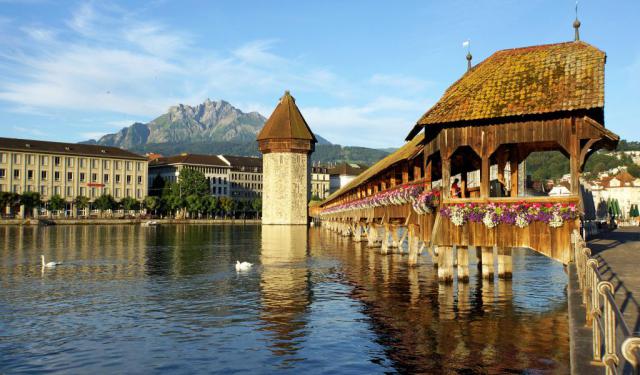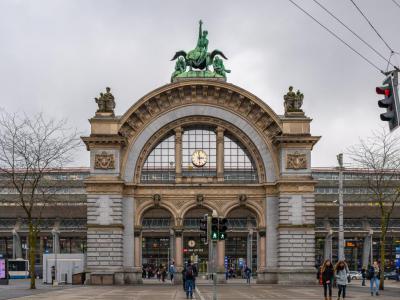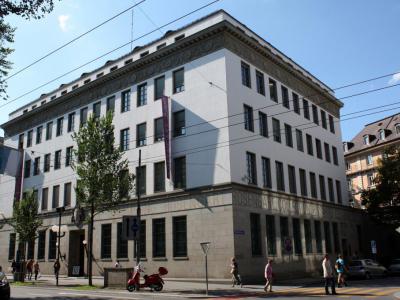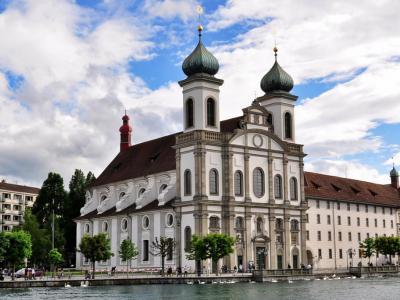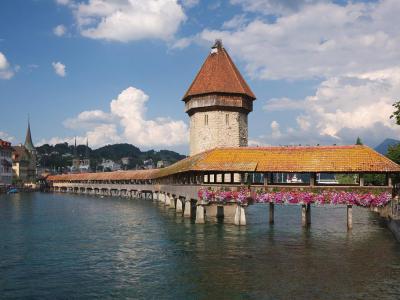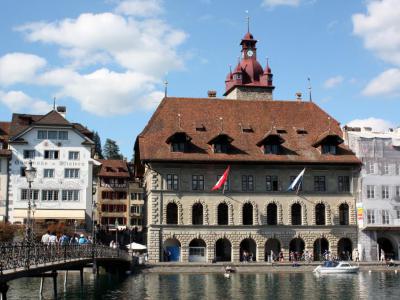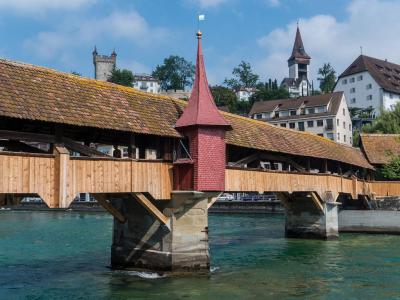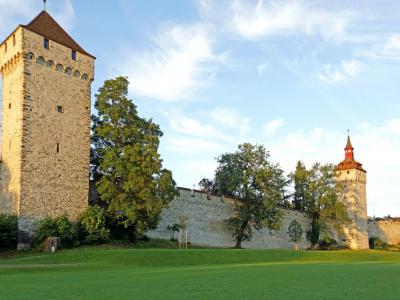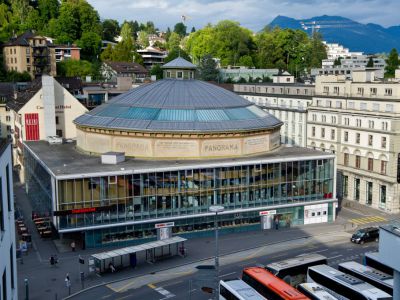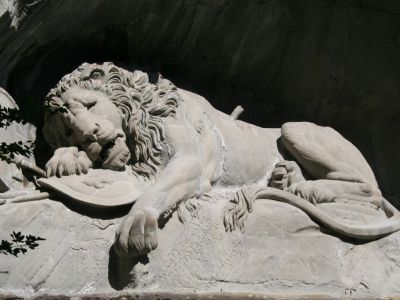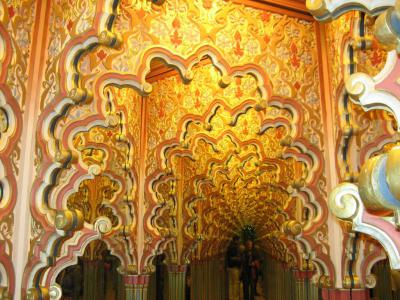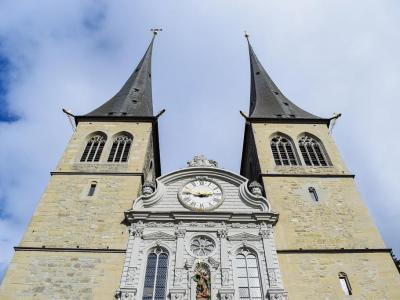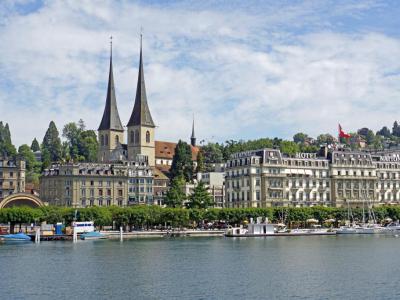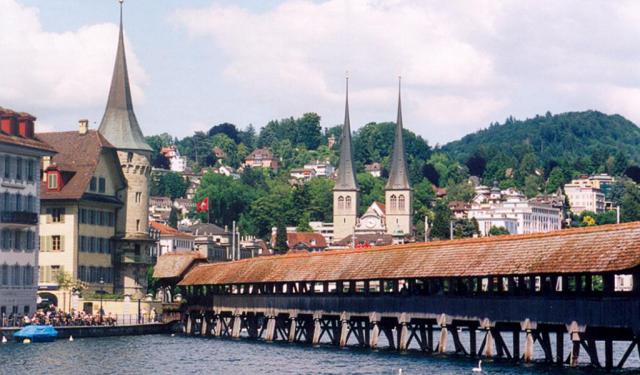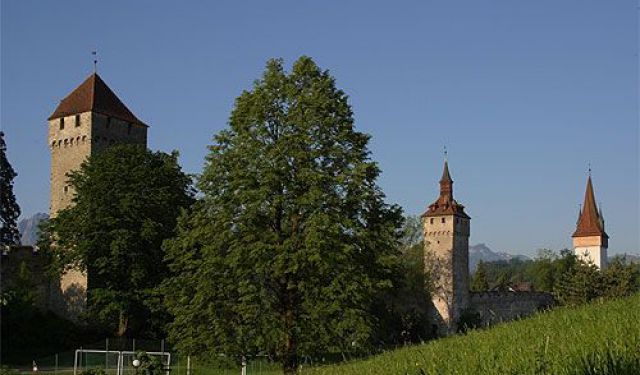Lucerne Introduction Walking Tour (Self Guided), Lucerne
Renowned for its well-preserved medieval architecture surpassed by majestic snowcapped Alps, Lucerne is one of the prettiest cities in Switzerland. Sitting compactly on the shore of the eponymous lake, its colorful Altstadt (Old Town) is bordered on the north by a 14-century rampart called Museggmauer (Musegg Wall).
The town grew around St Leodegar Abbey, established in 840 AD, on the territory known then as Luciaria. The origin of that name is uncertain – possibly derived from the Latin word for pike, lucius, thus designating a pike fishing spot in the river Reuss. The more popular etymology, however, associates it with Latin lucerna, which means "lantern".
In 1178 the town acquired independence and gained importance as a strategic gateway for commerce. It was among the growing towns of the Swiss confederacy, and especially popular in attracting new residents. In 1798, nine years after the beginning of the French Revolution, the French army marched into Switzerland, causing the collapse of the old confederacy and establishing democratic government.
In the second half of the 19th century Lucerne became a popular destination for artists, royalty and people of prominence. The German composer Richard Wagner settled here in 1866; British Queen Victoria boosted the city by her visit in 1868; and the American writer Mark Twain further popularized Lucerne in his travel writings after visiting twice, in 1878 and 1897.
Lucerne's status as a fashionable destination led to it becoming one of the first centers of modern-style tourism. Some of the city's most recognizable buildings are from that period, such as Lucerne Railway Station built in 1896.
Straddling the Reuss where it drains the lake, Lucerne has a number of bridges. The most famous of them is the Chapel Bridge (Kapellbrücke) – the oldest covered bridge in Europe, built in 1333. Further downriver there is another landmark overpass, the Spreuer Bridge (Spreuerbrücke), constructed in 1408.
The twin needle towers of the Church of St. Leodegar, which was named after the city's patron saint, sit on a small hill just above the lake front. Originally built in 735, the present Renaissance-style structure was erected in 1639.
Another not-to-miss local attraction is the carving of a dying lion (the Lion Monument, or Löwendenkmal) found in a small park just off the Löwenplatz.
To explore these and other major sights of Lucerne in more detail, take our self-guided introduction walk and enjoy yourself!
The town grew around St Leodegar Abbey, established in 840 AD, on the territory known then as Luciaria. The origin of that name is uncertain – possibly derived from the Latin word for pike, lucius, thus designating a pike fishing spot in the river Reuss. The more popular etymology, however, associates it with Latin lucerna, which means "lantern".
In 1178 the town acquired independence and gained importance as a strategic gateway for commerce. It was among the growing towns of the Swiss confederacy, and especially popular in attracting new residents. In 1798, nine years after the beginning of the French Revolution, the French army marched into Switzerland, causing the collapse of the old confederacy and establishing democratic government.
In the second half of the 19th century Lucerne became a popular destination for artists, royalty and people of prominence. The German composer Richard Wagner settled here in 1866; British Queen Victoria boosted the city by her visit in 1868; and the American writer Mark Twain further popularized Lucerne in his travel writings after visiting twice, in 1878 and 1897.
Lucerne's status as a fashionable destination led to it becoming one of the first centers of modern-style tourism. Some of the city's most recognizable buildings are from that period, such as Lucerne Railway Station built in 1896.
Straddling the Reuss where it drains the lake, Lucerne has a number of bridges. The most famous of them is the Chapel Bridge (Kapellbrücke) – the oldest covered bridge in Europe, built in 1333. Further downriver there is another landmark overpass, the Spreuer Bridge (Spreuerbrücke), constructed in 1408.
The twin needle towers of the Church of St. Leodegar, which was named after the city's patron saint, sit on a small hill just above the lake front. Originally built in 735, the present Renaissance-style structure was erected in 1639.
Another not-to-miss local attraction is the carving of a dying lion (the Lion Monument, or Löwendenkmal) found in a small park just off the Löwenplatz.
To explore these and other major sights of Lucerne in more detail, take our self-guided introduction walk and enjoy yourself!
How it works: Download the app "GPSmyCity: Walks in 1K+ Cities" from Apple App Store or Google Play Store to your mobile phone or tablet. The app turns your mobile device into a personal tour guide and its built-in GPS navigation functions guide you from one tour stop to next. The app works offline, so no data plan is needed when traveling abroad.
Lucerne Introduction Walking Tour Map
Guide Name: Lucerne Introduction Walking Tour
Guide Location: Switzerland » Lucerne (See other walking tours in Lucerne)
Guide Type: Self-guided Walking Tour (Sightseeing)
# of Attractions: 12
Tour Duration: 2 Hour(s)
Travel Distance: 4.2 Km or 2.6 Miles
Author: doris
Sight(s) Featured in This Guide:
Guide Location: Switzerland » Lucerne (See other walking tours in Lucerne)
Guide Type: Self-guided Walking Tour (Sightseeing)
# of Attractions: 12
Tour Duration: 2 Hour(s)
Travel Distance: 4.2 Km or 2.6 Miles
Author: doris
Sight(s) Featured in This Guide:
- Lucerne Railway Station
- Rosengart Collection
- Jesuit Church (Jesuitenkirche)
- Chapel Bridge
- Rathaus (Town Hall)
- Spreuer Bridge
- Museggmauer (Musegg Wall)
- Bourbaki Panorama
- Lion Monument
- Glacier Garden
- Church of St. Leodegar
- Lake Lucerne Promenade
1) Lucerne Railway Station (must see)
The Lucerne Railway Station is the main hub of Switzerland's rail network. It serves domestic and international traffic on several rail lines. The station is located in a waterfront location on the south side of Lake Lucerne just above the outflow of the Reuss river. A square occupies the area between the front of the station and the lakefront, and is heavily used by the local buses. The landing stages used by the passenger ships are located at the lakeside of the square, providing interchange between rail and water transport. An underground shopping mall lies below both the concourse of the railway station and the square.
The station building was built in 1896. It featured an amazing entrance hall with a distinctive cupola and an elegant curved roof. A fire broke out in 1971 and destroyed much of the building including the cupola, the station frontage and concourse.
A new station was eventually built, and opened on 5 February 1991, exactly 20 years after its predecessor was destroyed. The historic entrance portal facing the lake was re-erected to honor the legacy 1896 building. The portal is crowned by a sculpture named "Zeitgeist" by the well known Swiss sculptor, Richard Kissling.
The station building was built in 1896. It featured an amazing entrance hall with a distinctive cupola and an elegant curved roof. A fire broke out in 1971 and destroyed much of the building including the cupola, the station frontage and concourse.
A new station was eventually built, and opened on 5 February 1991, exactly 20 years after its predecessor was destroyed. The historic entrance portal facing the lake was re-erected to honor the legacy 1896 building. The portal is crowned by a sculpture named "Zeitgeist" by the well known Swiss sculptor, Richard Kissling.
2) Rosengart Collection (must see)
The Rosengart Collection, formerly the Picasso Museum, is fondly visited by art lovers who come to Switzerland. The museum's collections include sculptures, photographs and paintings. The best part is the collection entitled "Picasso, photographed by David Douglas Duncan", which features 200 photographs of Picasso himself. There are also many books and documentary films that reveal every detail of Picasso's life.
The former neoclassical building of the Swiss National Bank, built in 1923-1924 by the Zurich architect Hermann Herter, was bought and converted to he art museum which opened its doors on March 26, 2002.
The ground floor is devoted to the works of Picasso, the basement to those of Paul Klee, the famous Swiss painter with German origin, and the second floor to the works of other artists. The old meeting room of the bank is preserved as it was and accessible to visitors
The Rosengart is an incredible collection of paintings from the 19th and 20th centuries! In no other museum will you be able to enjoy the works of Picasso, Klee, Kandinsky and other masters with such calm and privacy. The collection also includes some of the most beautiful Chagall and Matisse paintings.
Tip:
Start with the video on the top floor, showing how the collection came about, and how Angela Rosengart was introduced to art at an early age by her father, an art dealer.
The former neoclassical building of the Swiss National Bank, built in 1923-1924 by the Zurich architect Hermann Herter, was bought and converted to he art museum which opened its doors on March 26, 2002.
The ground floor is devoted to the works of Picasso, the basement to those of Paul Klee, the famous Swiss painter with German origin, and the second floor to the works of other artists. The old meeting room of the bank is preserved as it was and accessible to visitors
The Rosengart is an incredible collection of paintings from the 19th and 20th centuries! In no other museum will you be able to enjoy the works of Picasso, Klee, Kandinsky and other masters with such calm and privacy. The collection also includes some of the most beautiful Chagall and Matisse paintings.
Tip:
Start with the video on the top floor, showing how the collection came about, and how Angela Rosengart was introduced to art at an early age by her father, an art dealer.
3) Jesuit Church (Jesuitenkirche) (must see)
The Lucerne Jesuit Church, located in Lucerne, is a prominent Catholic place of worship. It holds the distinction of being the first grand Baroque-style church constructed in northern Switzerland, situated above the Alps.
The Jesuit order, initiated by Ignatius of Loyola in 1534, played an active role in the Counter-Reformation, which was the Catholic response to the emergence of Protestantism. Protestant reformers like Zwingli in Zurich and Calvin in Geneva had caused a religious divide in predominantly Catholic Switzerland. In response to this situation, the Lucerne city council invited the Jesuits to establish a college in the year 1573.
Ludwig Pfyffer, who held the position of mayor in Lucerne, provided annual financial support to the Jesuits from his personal resources. The Jesuit College of Lucerne was officially founded in 1577, and it was housed in the Ritter Palace, a building originally constructed in 1557 to serve as the residence of Mayor Lux Ritter.
The construction of the associated church commenced in 1667, and by 1673, the basic structure of the church, including its main façade, had been completed. The church was consecrated in 1677, although the interior was not fully finished at that time. Numerous side altars were still missing, and even the high altar wasn't erected until four years later due to financial difficulties. The iconic onion-domed towers were not finished until 1893. In the mid-18th century, the vault underwent a redecoration. The original vestments of Brother Klaus, a renowned Swiss patron, are housed in the inner chapel.
Today, while the church presents an aesthetically pleasing exterior along the river promenade, its remarkable and unaltered pink and white interior truly captivates visitors. Entry to the church is free, and upon stepping inside, you will encounter one of the most magnificent churches in all of Switzerland.
The Jesuit order, initiated by Ignatius of Loyola in 1534, played an active role in the Counter-Reformation, which was the Catholic response to the emergence of Protestantism. Protestant reformers like Zwingli in Zurich and Calvin in Geneva had caused a religious divide in predominantly Catholic Switzerland. In response to this situation, the Lucerne city council invited the Jesuits to establish a college in the year 1573.
Ludwig Pfyffer, who held the position of mayor in Lucerne, provided annual financial support to the Jesuits from his personal resources. The Jesuit College of Lucerne was officially founded in 1577, and it was housed in the Ritter Palace, a building originally constructed in 1557 to serve as the residence of Mayor Lux Ritter.
The construction of the associated church commenced in 1667, and by 1673, the basic structure of the church, including its main façade, had been completed. The church was consecrated in 1677, although the interior was not fully finished at that time. Numerous side altars were still missing, and even the high altar wasn't erected until four years later due to financial difficulties. The iconic onion-domed towers were not finished until 1893. In the mid-18th century, the vault underwent a redecoration. The original vestments of Brother Klaus, a renowned Swiss patron, are housed in the inner chapel.
Today, while the church presents an aesthetically pleasing exterior along the river promenade, its remarkable and unaltered pink and white interior truly captivates visitors. Entry to the church is free, and upon stepping inside, you will encounter one of the most magnificent churches in all of Switzerland.
4) Chapel Bridge (must see)
The Chapel Bridge is a wooden foot bridge that stretches diagonally across the Reuss River in Lucerne. It got its name from Saint Peter's Chapel nearby. What makes this bridge special is that it has some old paintings inside from the 17th century. Unfortunately, many of these paintings were destroyed in a fire that happened in 1993, which also damaged most of the bridge. Thankfully, they fixed it up afterward. This bridge is not just any bridge; it's actually the oldest covered wooden bridge in Europe and the world's oldest surviving truss bridge. People in Lucerne really like it, and it's a famous tourist spot in Switzerland.
Originally, they built this bridge in 1333 as part of Lucerne's defenses. It connected the old town on one side of the river to the new town on the other side, which helped protect the city from attacks coming from the south of Lake Lucerne. At first, it was more than 200 meters long, but over time, they made it shorter and did some work on the riverbanks, so now it's 170 meters long.
Lucerne is special because it has three wooden pedestrian bridges: the Hof Bridge from the 14th century (but that one's gone now), the Chapel Bridge, and the Spreuer Bridge from the 16th century. All of them have paintings on the inside in triangle-shaped frames. No other wooden footbridges in Europe have this. The paintings on the Chapel Bridge were made in the 17th century by a local Catholic painter named Hans Heinrich Wagmann. They show things from Lucerne's history. There used to be 147 paintings on the bridge before the fire in 1993, but they could only fully restore 30 of them.
Tip:
Experience it at night with the city lights, swans, flowers and romantic atmosphere. Both banks are full of great shopping and fantastic restaurants.
Originally, they built this bridge in 1333 as part of Lucerne's defenses. It connected the old town on one side of the river to the new town on the other side, which helped protect the city from attacks coming from the south of Lake Lucerne. At first, it was more than 200 meters long, but over time, they made it shorter and did some work on the riverbanks, so now it's 170 meters long.
Lucerne is special because it has three wooden pedestrian bridges: the Hof Bridge from the 14th century (but that one's gone now), the Chapel Bridge, and the Spreuer Bridge from the 16th century. All of them have paintings on the inside in triangle-shaped frames. No other wooden footbridges in Europe have this. The paintings on the Chapel Bridge were made in the 17th century by a local Catholic painter named Hans Heinrich Wagmann. They show things from Lucerne's history. There used to be 147 paintings on the bridge before the fire in 1993, but they could only fully restore 30 of them.
Tip:
Experience it at night with the city lights, swans, flowers and romantic atmosphere. Both banks are full of great shopping and fantastic restaurants.
5) Rathaus (Town Hall)
The Lucerne Town Hall, known as Rathaus, is an Italian Renaissance style building that is considered by many to be one of the most beautiful historical buildings in Lucerne. Construction began on Rathaus in 1602 and was completed in 1606. It was designed by architect Anton Isenmann.
Rathaus is located in the heart of Old Town. Its location on the River Reuss offers perfect photo ops for visitors who want a great view of the Chapel Bridge. This is particularly true on Tuesdays and Saturdays from 6 AM to 1 PM when market stalls open and tourists can partake in shopping while admiring the architecture.
Inside the building, visitors will find an exhibit hall and a concert hall. They may view the paintings and coffered ceilings from long ago as they find their way to the dovecote. Located in the Rathaus attic, the dovecote lets visitors both watch and feed the birds. They can even enjoy an exhibit that details the history of the Rathaus doves.
Rathaus is located in the heart of Old Town. Its location on the River Reuss offers perfect photo ops for visitors who want a great view of the Chapel Bridge. This is particularly true on Tuesdays and Saturdays from 6 AM to 1 PM when market stalls open and tourists can partake in shopping while admiring the architecture.
Inside the building, visitors will find an exhibit hall and a concert hall. They may view the paintings and coffered ceilings from long ago as they find their way to the dovecote. Located in the Rathaus attic, the dovecote lets visitors both watch and feed the birds. They can even enjoy an exhibit that details the history of the Rathaus doves.
6) Spreuer Bridge (must see)
Spreuer Bridge is a covered, wooden footbridge that begins in the Mills Square in old town and ends in Pfister Alley. Also called the Mills Bridge, it is a popular spot for tourists who wish to see both the stunning architecture and the interior paintings.
The original bridge was constructed in the 13th century but was destroyed by a flood in 1566. It was rebuilt shortly thereafter, which was when the paintings were added. The paintings are the largest known paintings of the Dance of Death during the late Middle Ages.
Kaspar Meglinger directed the 67 paintings from 1616 to 1637. Most paintings contain information about the donors, including their names and family coat-of-arms. Some also have portraits of the donors. Forty-five of those paintings have survived. The paintings at Spreuer Bridge have also created the nickname "The Dance of Death Bridge."
Visitors are welcome to walk across the pedestrian bridge at any time, though the paintings are best viewed with natural daylight.
The original bridge was constructed in the 13th century but was destroyed by a flood in 1566. It was rebuilt shortly thereafter, which was when the paintings were added. The paintings are the largest known paintings of the Dance of Death during the late Middle Ages.
Kaspar Meglinger directed the 67 paintings from 1616 to 1637. Most paintings contain information about the donors, including their names and family coat-of-arms. Some also have portraits of the donors. Forty-five of those paintings have survived. The paintings at Spreuer Bridge have also created the nickname "The Dance of Death Bridge."
Visitors are welcome to walk across the pedestrian bridge at any time, though the paintings are best viewed with natural daylight.
7) Museggmauer (Musegg Wall) (must see)
The historic city wall was once part of the fortification of Lucerne. Today Musegg Wall is a beautiful reminder of the past that can be explored up close or viewed from afar.
The wall and nine towers were built in the 13th century. They originally consisted of an inner ring and an outer ring. With much of it still preserved, it is one of the longest defensive walls still standing in the country. Those wishing to walk by the nine towers may do so at anytime as they are all floodlit at night. However, only four are open to public: Mannli, Zyt, Wacht and Schirmer.
Mannli, meaning "little man" is the second tower on the ascending ridge. It was used for military purposes through the end of World War II before it was eventually opened to the public. Wacht Tower, also called Heu Tower, was used for storing gunpowder. It was rebuilt after a 1701 lightning strike caused an explosion. Zyt Tower is a clock tower whose bell, the Leodegar Bell, strikes the hour prior to the city's church clocks. Schirmer Tower holds the city gate.
Musegg Wall and four of its nine towers are open to the public from 8 AM to 7 PM from April through November.
The wall and nine towers were built in the 13th century. They originally consisted of an inner ring and an outer ring. With much of it still preserved, it is one of the longest defensive walls still standing in the country. Those wishing to walk by the nine towers may do so at anytime as they are all floodlit at night. However, only four are open to public: Mannli, Zyt, Wacht and Schirmer.
Mannli, meaning "little man" is the second tower on the ascending ridge. It was used for military purposes through the end of World War II before it was eventually opened to the public. Wacht Tower, also called Heu Tower, was used for storing gunpowder. It was rebuilt after a 1701 lightning strike caused an explosion. Zyt Tower is a clock tower whose bell, the Leodegar Bell, strikes the hour prior to the city's church clocks. Schirmer Tower holds the city gate.
Musegg Wall and four of its nine towers are open to the public from 8 AM to 7 PM from April through November.
8) Bourbaki Panorama (must see)
The Bourbaki Panorama is a giant, panoramic painting that pays homage to the internment of the 87,000 French Bourbaki soldiers who made their way from Prussia to Switzerland during the winter of 1871. The artist, Edouard Castres, had a first-hand account of this occurrence. He created the painting after seeing the horrors of war as a Red Cross worker.
The incident happened during the Franco-Prussian War. General Charles Bourbaki's French forces fled to Switzerland. They were starving and facing disease, but the Swiss army found homes for them where they could rest during the harsh winter.
The Bourbaki Panorama is on a 112x10 meter canvas. It is thought to be the inspiration for 360 degree filming and virtual reality due to its size and shape. Visitors can go to the museum to see this important painting any day of the week. It opens at 10 am throughout the year. The museum closes at 5 pm from November to March and at 6 pm from April through October.
Tip:
The Bourbaki Panorama is actually comprised of two levels; the first is a video/slide presentation (plus several artifacts), while the upper level is a spectacular 3D presentation with life-size figures in front of the actual painting. Be sure to study the story in order to understand the situation depicted.
The incident happened during the Franco-Prussian War. General Charles Bourbaki's French forces fled to Switzerland. They were starving and facing disease, but the Swiss army found homes for them where they could rest during the harsh winter.
The Bourbaki Panorama is on a 112x10 meter canvas. It is thought to be the inspiration for 360 degree filming and virtual reality due to its size and shape. Visitors can go to the museum to see this important painting any day of the week. It opens at 10 am throughout the year. The museum closes at 5 pm from November to March and at 6 pm from April through October.
Tip:
The Bourbaki Panorama is actually comprised of two levels; the first is a video/slide presentation (plus several artifacts), while the upper level is a spectacular 3D presentation with life-size figures in front of the actual painting. Be sure to study the story in order to understand the situation depicted.
9) Lion Monument (must see)
The Lion Monument, also known as the Lion of Lucerne, is a carved rock sculpture located in Lucerne, Switzerland. It was crafted in 1820 to honor the memory of the Swiss Guards who tragically lost their lives in 1792 during the French Revolution. This somber event occurred when revolutionaries attacked the Tuileries Palace in Paris. The Lion Monument stands as one of Switzerland's most renowned landmarks and draws approximately 1.4 million tourists annually.
Starting in the early 17th century, a Swiss Guards regiment had been a part of the Royal Army of France. On August 10th, 1792, as revolutionaries overran the palace, conflict erupted spontaneously after the royal family had been evacuated from the Tuileries to seek shelter with the Legislative Assembly. The Swiss Guards found themselves running out of ammunition and were ultimately overwhelmed by the numerically superior revolutionary forces.
In the course of the fighting or in the aftermath of their surrender, approximately 760 Swiss Guards who had defended the Tuileries lost their lives. An additional two hundred succumbed to their injuries while in prison or fell victim to the September Massacres that ensued.
The Lion Monument, an impressive piece of rock art carved into a cliff face, measures an imposing ten meters in length and six meters in height. It is dedicated to honoring the loyalty and courage of the Swiss. The sculpture depicts a dying lion impaled by a spear, with a shield bearing the emblem of the French monarchy covering its body. Adjacent to the lion, there is another shield bearing the coat of arms of Switzerland.
Mark Twain famously referred to this sculpture of a mortally wounded lion as "the most mournful and moving piece of stone in the world."
Starting in the early 17th century, a Swiss Guards regiment had been a part of the Royal Army of France. On August 10th, 1792, as revolutionaries overran the palace, conflict erupted spontaneously after the royal family had been evacuated from the Tuileries to seek shelter with the Legislative Assembly. The Swiss Guards found themselves running out of ammunition and were ultimately overwhelmed by the numerically superior revolutionary forces.
In the course of the fighting or in the aftermath of their surrender, approximately 760 Swiss Guards who had defended the Tuileries lost their lives. An additional two hundred succumbed to their injuries while in prison or fell victim to the September Massacres that ensued.
The Lion Monument, an impressive piece of rock art carved into a cliff face, measures an imposing ten meters in length and six meters in height. It is dedicated to honoring the loyalty and courage of the Swiss. The sculpture depicts a dying lion impaled by a spear, with a shield bearing the emblem of the French monarchy covering its body. Adjacent to the lion, there is another shield bearing the coat of arms of Switzerland.
Mark Twain famously referred to this sculpture of a mortally wounded lion as "the most mournful and moving piece of stone in the world."
10) Glacier Garden (must see)
Glacier Garden is the place to go to learn as much as possible about ice age glaciers. Visitors will walk through the museum and gardens where they will find the Rock Adventure Trail, which allows them to effectively walk through the rock and see how it was formed during the Ice Age.
The museum is in a traditional Swiss house. It has an 18th century mountain relief map, which is the oldest in the world. There is also an interactive relief map of Switzerland. After going through the museum, visitors can see themselves in the Mirror Mazer. Made from 90 mirrors, this 19th century maze offers a fun and interesting distraction.
An Observation Tower provides stunning views of Lucerne. Visitors can also find a the perfect area in the park to rest or have an outdoor picnic.
Glacier Garden is open daily from 10 am to 6 pm during the summer season and from 10 am to 5 pm through the winter months.
The museum is in a traditional Swiss house. It has an 18th century mountain relief map, which is the oldest in the world. There is also an interactive relief map of Switzerland. After going through the museum, visitors can see themselves in the Mirror Mazer. Made from 90 mirrors, this 19th century maze offers a fun and interesting distraction.
An Observation Tower provides stunning views of Lucerne. Visitors can also find a the perfect area in the park to rest or have an outdoor picnic.
Glacier Garden is open daily from 10 am to 6 pm during the summer season and from 10 am to 5 pm through the winter months.
11) Church of St. Leodegar (must see)
The Church of Saint Leodegar is a 17th century Roman Catholic church. The building was completed in 1639, though the history of the church can be traced as far back as the 8th century.
An older church known as Monastarium Luciaria once stood on the site where the Church of Saint Leodegar now stands. It was built around 735 or 736 AE and had many years of patronage. Unfortunately, that building burned in 1633. All that was left behind were two Romanesque towers.
Many consider the Church of Saint Leodegar to be the most important example of a church using Renaissance architecture in Switzerland. It is also notable for its organ, which was built in 1640. At the time of its original built, the organ had the tallest and heaviest pipe in the world. It was extended in 1862 and again in the 1970s. There are now 7,374 pipes and 111 registers.
Visitors who wish to see the Church of Saint Leodegar may visit on weekdays from 8 am to noon and from 2 PM to 5 pm.
An older church known as Monastarium Luciaria once stood on the site where the Church of Saint Leodegar now stands. It was built around 735 or 736 AE and had many years of patronage. Unfortunately, that building burned in 1633. All that was left behind were two Romanesque towers.
Many consider the Church of Saint Leodegar to be the most important example of a church using Renaissance architecture in Switzerland. It is also notable for its organ, which was built in 1640. At the time of its original built, the organ had the tallest and heaviest pipe in the world. It was extended in 1862 and again in the 1970s. There are now 7,374 pipes and 111 registers.
Visitors who wish to see the Church of Saint Leodegar may visit on weekdays from 8 am to noon and from 2 PM to 5 pm.
12) Lake Lucerne Promenade
The Lake Lucerne Promenade is arguably the best place in the city to take an easy walk. Visitors can join the locals as they stroll along the shore of Lake Lucerne. They can stop to watch the boats, gaze at the Alps, play games or sample one of the local restaurants. Many tourists simply enjoy having a place to sit and relax.
Some of the most popular draws of the Lake Lucerne Promenade are the summer concerts. Free, public concerts are available in the pavilion to anyone who wishes to enjoy listening to music in the open air. This tradition has been going strong since 1908. The evening concerts take place from May to September on Tuesdays and Fridays at 8:15 PM. Morning concerts are available at 10:15 AM.
The promenade is in a central location that has easy to access to other tourist sites. Visitors to Lucerne can easily add a side trip to the promenade as they explore the Church of Saint Leodegar, which is only a three minute walk. Just a bit further is the Bourbaki Panorama. Neither should be missed on a trip to Lucerne.
Some of the most popular draws of the Lake Lucerne Promenade are the summer concerts. Free, public concerts are available in the pavilion to anyone who wishes to enjoy listening to music in the open air. This tradition has been going strong since 1908. The evening concerts take place from May to September on Tuesdays and Fridays at 8:15 PM. Morning concerts are available at 10:15 AM.
The promenade is in a central location that has easy to access to other tourist sites. Visitors to Lucerne can easily add a side trip to the promenade as they explore the Church of Saint Leodegar, which is only a three minute walk. Just a bit further is the Bourbaki Panorama. Neither should be missed on a trip to Lucerne.
Walking Tours in Lucerne, Switzerland
Create Your Own Walk in Lucerne
Creating your own self-guided walk in Lucerne is easy and fun. Choose the city attractions that you want to see and a walk route map will be created just for you. You can even set your hotel as the start point of the walk.
Lucerne's Architectural Jewels Walking Tour
Lucerne's long religious and cultural history is duly reflected in its architecture, making it one of the most popular tourist destinations in Switzerland. There are quite a few places in the city that need not strive for attention and can easily catch the eye of any passer-by. Such like are:
The Lucerne Railway Station – an architectural jewel and main hub of the Swiss railway network,... view more
Tour Duration: 2 Hour(s)
Travel Distance: 2.3 Km or 1.4 Miles
The Lucerne Railway Station – an architectural jewel and main hub of the Swiss railway network,... view more
Tour Duration: 2 Hour(s)
Travel Distance: 2.3 Km or 1.4 Miles
Lucerne's Towers Walking Tour
Lucerne boasts a wealth of spectacular medieval towers, located in the Musegg Wall area. This former symbol of power forms an impressive city crown, shaping up its skyline, and affording great panoramic views of Lucerne and the eponymous lake, the Reuss river, and the surrounding mountain scenery.
Built in the 13th-14th centuries, the 870-meter wall, complete with its nine towers, is one of... view more
Tour Duration: 1 Hour(s)
Travel Distance: 1.0 Km or 0.6 Miles
Built in the 13th-14th centuries, the 870-meter wall, complete with its nine towers, is one of... view more
Tour Duration: 1 Hour(s)
Travel Distance: 1.0 Km or 0.6 Miles
The Most Popular Cities
/ view all
